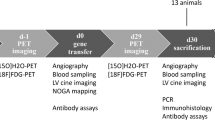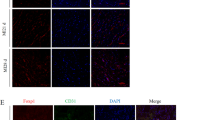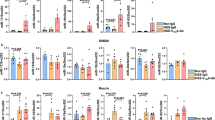Abstract
Therapeutic angiogenesis with gene encoding vascular endothelial growth factor (VEGF) is a new potential treatment in cardiovascular disease. However, unregulated VEGF-mediated angiogenesis has the potential to promote tumor growth, accelerate diabetic proliferative retinopathy, and promote rupture of atherosclerotic plaque. To be safe and effective, gene therapy with VEGF must be regulated. To limit the risk of pathological angiogenesis, we developed a hypoxia-inducible VEGF gene therapy system using the erythropoietin (Epo) enhancer and water-soluble lipopolymer (WSLP). pEpo-SV-VEGF or pSV-VEGF-Epo was constructed by insertion of the Epo enhancer upstream of the Simian Virus 40 (SV40) promoter or downstream of the poly(A) signal of pSV-VEGF. In vitro transfection showed that pEpo-SV-VEGF, not pSV-VEGF-Epo, induced the VEGF expression in hypoxic cells. In addition, the VEGF protein, which was produced from the Epo-SV-VEGF-transfected and hypoxia-incubated cells, was able to enhance the proliferation of the endothelial cells. Injection of the pEpo-SV-VEGF/WSLP complex showed that the expression of VEGF was induced in ischemic myocardium, compared to normal myo-cardium. Therefore, with the localized induction of VEGF and the low cytotoxicity of WSLP, the pEpo-SV-VEGF/WSLP system may be helpful to eventually treat ischemic heart disease.
This is a preview of subscription content, access via your institution
Access options
Subscribe to this journal
Receive 12 print issues and online access
$259.00 per year
only $21.58 per issue
Buy this article
- Purchase on Springer Link
- Instant access to full article PDF
Prices may be subject to local taxes which are calculated during checkout






Similar content being viewed by others
References
Stone D et al. Viral vectors for gene delivery and gene therapy within the endocrine system. J Endocrinol 2000; 164: 103–118.
Han S, Mahato RI, Sung YK, Kim SW . Development of biomaterials for gene therapy. Mol Ther 2000; 2: 302–317.
Han S, Mahato RI, Kim SW . Water-soluble lipopolymer for gene delivery. Bioconjug Chem 2001; 12: 337–345.
Lee M, Han S, Ko KS, Kim SW . Cell type specific and glucose responsive expression of interleukin-4 by using insulin promoter and water soluble lipopolymer. J Control Release 2001; 75: 421–429.
Lee M et al. Water soluble lipopolymer as an efficient carrier for gene delivery to myocardium. Gene Therapy 2003; 10: 585–593.
Isner JM . Myocardial gene therapy. Nature 2002; 415: 234–239.
Brogi E et al. Hypoxia-induced paracrine regulation of vascular endothelial growth factor receptor expression. J Clin Invest 1996; 97: 469–476.
Lee JS, Feldman AM . Gene therapy for therapeutic myocardial angiogenesis: a promising synthesis of two emerging technologies. Nat Med 1998; 4: 739–742.
Springer ML et al. VEGF gene delivery to muscle: potential role for vasculogenesis in adults. Mol Cell 1998; 2: 549–558.
Lee RJ et al. VEGF gene delivery to myocardium; deleterious effects of unregulated expression. Circulation 2000; 102: 898–901.
Maxwell PH, Pugh CW, Ratcliffe PJ . Inducible operation of the erythropoietin 3′ enhancer in multiple cell lines; evidence for a widespread oxygen-sensing mechanism. Proc Natl Acad Sci USA 1993; 90: 2423–2427.
Jiang B–H et al. Dimerization, DNA binding, and transactivation properties of hypoxia-inducible factor 1. J Biol Chem 1996; 271: 17771–17778.
Wang GL, Semenza GL . General involvement of hypoxia-inducible factor 1 in transcriptional response to hypoxia. Proc Natl Acad Sci USA 1993; 90: 4304–4308.
Chavand O, Spilsbury K, Rakoczy PE . Addition of a c-myc epitope tag within the VEGF protein does not affect in vitro biological activity. Biochem Cell Biol 2001; 79: 107–112.
Levy AP, Levy NS, Wegner S, Goldberg MA . Transcriptional regulation of the rat vascular endothelial growth factor gene by hypoxia. J Biol Chem 1995; 270: 13333–13340.
Liu Y, Cox SR, Morita T, Kourembanas S . Hypoxia regulates vas-cular endothelial growth factor gene expression in endothelial cells. Identification of a 5′ enhancer. Circ Res 1995; 77: 638–643.
Forsythe JA et al. Activation of vascular endothelial growth factor gene transcription by hypoxia-inducible factor 1. Mol Cell Biol 1996; 16: 4604–4613.
Stein I et al. (1995) Stabilization of vascular endothelial growth factor mRNA by hypoxia and hypoglycemia and coregulation with other ischemia-induced genes. Mol Cell Biol 1995; 15: 5363–5368.
Dibbens JA et al. Hypoxic regulation of vascular endothelial growth factor mRNA stability requires the cooperation of multiple RNA elements. Mol Biol Cell 1999; 10: 907–919.
Su H, Arakawa-Hoyt J, Kan YW . Adeno-associated viral vector-mediated hypoxia response element-regulated gene expression in mouse ischemic heart model. Proc Natl Acad Sci USA 2002; 99: 9480–9485.
Chomczynski P, Sacchi N . Single-step method of RNA isolation by acid guanidinium thiocyanate–phenol–chloroform extraction. Anal Biochem 1987; 162: 156–159.
Operschall C, Falivene L, Clozel JP, Roux S . A new model of chronic cardiac ischemia in rabbits. J Appl Physiol 2000; 88: 1438–1445.
Acknowledgements
We thank Expression Genetics Inc. for financial support and Thomas Skidmore and Michael Skidmore for technical assistance. This work was supported by National Institutes of Health Grant HL65477.
Author information
Authors and Affiliations
Rights and permissions
About this article
Cite this article
Lee, M., Rentz, J., Bikram, M. et al. Hypoxia-inducible VEGF gene delivery to ischemic myocardium using water-soluble lipopolymer. Gene Ther 10, 1535–1542 (2003). https://doi.org/10.1038/sj.gt.3302034
Received:
Accepted:
Published:
Issue Date:
DOI: https://doi.org/10.1038/sj.gt.3302034
Keywords
This article is cited by
-
Triazine-cored polymeric vectors for antisense oligonucleotide delivery in vitro and in vivo
Journal of Nanobiotechnology (2020)
-
Gene delivery of hypoxia-inducible VEGF targeting collagen effectively improves cardiac function after myocardial infarction
Scientific Reports (2017)
-
Delivery of Hypoxia-Inducible Heme Oxygenase-1 Gene for Site-Specific Gene Therapy in the Ischemic Stroke Animal Model
Pharmaceutical Research (2016)
-
Hypoxia-Sensitive Materials for Biomedical Applications
Annals of Biomedical Engineering (2016)
-
Polyethylenimine-modified Pluronics (PCMs) Improve Morpholino Oligomer Delivery in Cell Culture and Dystrophic mdx Mice
Molecular Therapy (2013)



